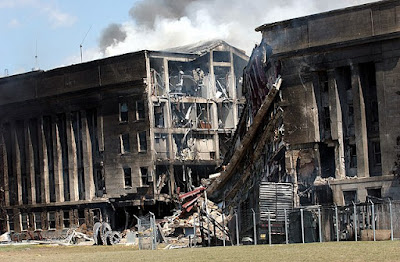 |
Plumes of smoke from The World Trade Center twin towers on Sept. 11, 2001. From Wikimedia Commons via flickr poster Michael Foran.
|
Today is Sept. 4, which means the 20th anniversary of the Sept. 11, 2001 attacks on the United States is one week from today.
The 9/11 events were so big that “9/11” is all one has to say and everyone knows you don’t mean any Sept. 11—you mean that Sept. 11.
The world didn’t exactly change 20 years ago. The forces that attacked my country that day had been at work for some time—indeed, there had previous bombing attempts to destroy the World Trade Center. But that September day, sunny and beautiful in Iowa, at least in my memory, was still a pivotal day.
 |
From the FBI's web site, FBI.gov, a timeline of Sept. 11, 2001.
|
I have a little trouble picturing myself at 43. I was already greying—did I still have some dark hair? A man in his 60s has a little trouble picturing the world of the 40-something year old. Much in my life has remained the same, and much has changed.
On Sept. 11, 2001, I had a son in elementary school. My oldest daughter was nearing the end of high school, but was adjusting to a large public school—Linn Mar High School—after her first two years of secondary education had been at a tiny Catholic High School—St. Mary’s in Storm Lake, Iowa.
We had just bought a house in Cedar Rapids. The next year would be financially a little dicey for us, as we owned two houses. But both my wife and I had jobs, she at the birth center at Mercy Medical Center (where she would become the nurse manager in a few years), me at the start of a new career. I was fresh out of the world of journalism and into the world of academia, less than a month into my new job teaching at what was then Mount Mercy College.
 |
A hole in the Pentagon in Washington, D.C. on Sept. 11, 2001. Defense Department image by Cpl. Jason Ingersoll, USMC, downloaded from Wikimedia Commons.
|
That Tuesday, I was buying tires for our van. I was at a tire shop near Lindale Mall that morning, and it was a very strange morning. Very few people were out, and I was the only customer at what would usually be a busy shop. I think six guys were working on replacing my tires, each taking 2-minute shifts or so before they traded off—the rest to join me in the customer lounge, watching TV. Special report from New York, a plane has struck the World Trade Center. Then, another. The Pentagon. A planned second attack on Washington, D.C., ending with a crashed plane in Pennsylvania.
I can’t recall a lot from that day other than the sense of shock. I was teaching a class that fall that I’m teaching this semester, too—CO 280, Writing for Public Relations. It was an afternoon class, I think, and I scrapped my lesson plan.
We rearranged the room in a big circle. And the students and I just talked about it, the big news of the day.
 |
My wife and I visited the Newseum in Washington, D.C. during spring break, March, 2015. This is a ruined TV tower that been atop the World Trade Center on display at that museum.
|
And here we are, almost 20 years later. Two decade of grappling with new realities, of questioning what freedom means, of foreign wars and increasing polarization at home. The internet existed in 2001, but way back then we didn’t carry it around in our pockets and we still watched big events on a chunky, square TV in the customer lounge of a tire shop.
I am just starting to look into it, but I don’t think our current era of struggling with fakery on social media is unrelated to 9/11. That day shook America to its core, and became one of those improbable, shocking events around which wild conspiracy theories swirl.
 |
Another image from that 2015 visit to the Newseum. A wall of headlines reporting 9/11 attacks, from an era when news media mattered more than social media.
|
Partly, of course, because it was the result of a shadowy conspiracy, and unpacking it is a process historians will be tied up with for decades.
What does it all mean? A lot, and I’m glad that Mount Mercy University will spend some time grappling with this key world event.
Every year, faculty at MMU designated a topic for a series of public discussions—the Fall Faculty Series. I am proud to have helped start this with our first series in 2014 being on the 100th anniversary of the start of World War I.
This year, the Series has a very simple title: 9/11: Twenty Years Later.” Five faculty members, including me, will give free, public Wednesday talks, all of which will start at 6 p.m., and all of which will take place in Flaherty Community Room in Basile Hall.
 |
Logo of 2021 Fall Faculty Series at Mount Mercy University.
|
Here is the schedule, the topics and the speakers:
- Sept. 29, Precursor Events: At War before 9/11, James Jacobs, associate professor of computer science.
- Oct. 6, Conspiracy, Myth, and Misinformation, Joe Sheller, associate professor of communication & MMU Times advisor.
- Oct. 27, Heroism and Sacrifice after the Attack, Norma Linda Mattingly, associate professor of education.
- Nov. 9, Fear and Trauma after 9/11, Dennis Dew, associate professor of psychology.
- December 1, Reflections of a Muslim-American Immigrant, Ayman Amer | associate professor of economics.








